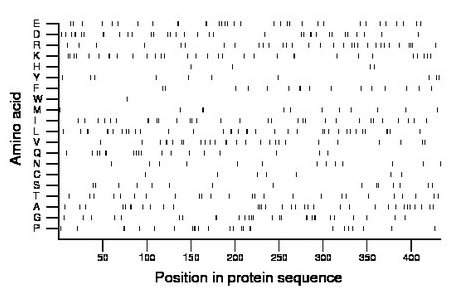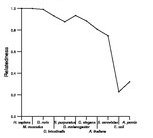
| Name: PSMC2 | Sequence: fasta or formatted (433aa) | NCBI GI: 4506209 | |
|
Description: proteasome 26S ATPase subunit 2
|
Referenced in:
| ||
|
Composition:

Amino acid Percentage Count Longest homopolymer A alanine 7.6 33 2 C cysteine 1.6 7 1 D aspartate 8.1 35 2 E glutamate 7.6 33 2 F phenylalanine 3.7 16 2 G glycine 6.5 28 2 H histidine 0.9 4 1 I isoleucine 7.2 31 2 K lysine 7.4 32 2 L leucine 8.5 37 2 M methionine 2.8 12 2 N asparagine 3.0 13 1 P proline 5.8 25 2 Q glutamine 4.2 18 2 R arginine 7.2 31 2 S serine 3.5 15 1 T threonine 5.8 25 1 V valine 6.2 27 2 W tryptophan 0.2 1 1 Y tyrosine 2.3 10 1 |
Comparative genomics:
Search single species RefSeq proteins at NCBI
Search summary 
Figure data | ||
Related human proteins:Protein Relative score Description Self-match 1.000 proteasome 26S ATPase subunit 2 PSMC5 0.384 proteasome 26S ATPase subunit 5 PSMC6 0.356 proteasome 26S ATPase subunit 6 PSMC1 0.345 proteasome 26S ATPase subunit 1 PSMC3 0.323 proteasome 26S ATPase subunit 3 LOC652826 0.310 PREDICTED: similar to proteasome 26S ATPase subunit ... PSMC4 0.310 proteasome 26S ATPase subunit 4 isoform 2 PSMC4 0.310 proteasome 26S ATPase subunit 4 isoform 1 LOC345645 0.271 PREDICTED: similar to hCG2002932 LOC345645 0.271 PREDICTED: similar to hCG2002932 LOC345645 0.271 PREDICTED: hypothetical protein LOC345645 AFG3L2 0.221 AFG3 ATPase family gene 3-like 2 VCP 0.218 valosin-containing protein SPATA5 0.212 spermatogenesis associated 5 ATAD2 0.189 ATPase family, AAA domain containing 2 SPG7 0.187 spastic paraplegia 7 isoform 1 ATAD2B 0.186 ATPase family, AAA domain containing 2B NVL 0.180 nuclear VCP-like isoform 2 NVL 0.180 nuclear VCP-like isoform 1 YME1L1 0.177 YME1-like 1 isoform 1 YME1L1 0.177 YME1-like 1 isoform 3 SPATA5L1 0.171 spermatogenesis associated 5-like 1 PEX1 0.160 peroxin1 PEX6 0.160 peroxisomal biogenesis factor 6 KATNAL1 0.150 katanin p60 subunit A-like 1 KATNAL1 0.150 katanin p60 subunit A-like 1 KATNA1 0.146 katanin p60 subunit A 1 FIGNL1 0.136 fidgetin-like 1 FIGNL1 0.136 fidgetin-like 1 VPS4B 0.126 vacuolar protein sorting factor 4BHuman BLASTP results (used to prepare the table) | |||
Gene descriptions are from NCBI RefSeq. Search results were obtained with NCBI BLAST and RefSeq entries. When identical proteins are present, the self-match may not be listed first in BLASTP output. In such cases, the table above has been reordered to place it first.
See About the Figures for the scoring system used in the figure above right. The same scoring system was used in the table of BLASTP results.
Guide to the Human Genome
Copyright © 2010 by Stewart Scherer. All rights reserved.
